Chevrolet Silverado 1500 2002 Owner's Manual
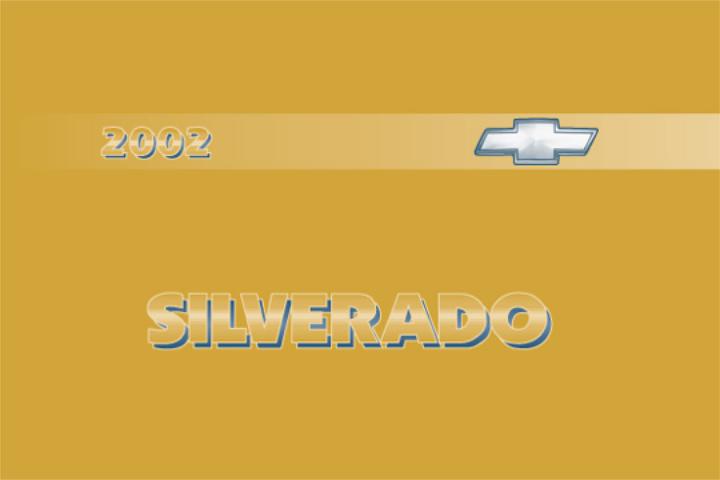

2002 Chevrolet Silverado
Owner's Manual
Litho in U.S.A. |
ECopyright General Motors Corporation 06/18/01 |
Part Number C2215 A First Edition |
All Rights Reserved |
i

GENERAL MOTORS, GM, the GM Emblem, CHEVROLET, the CHEVROLET Emblem and the name SILVERADO are registered trademarks of General Motors Corporation.
This manual includes the latest information at the time it was printed. We reserve the right to make changes after that time without further notice. For vehicles first sold in Canada, substitute the name ªGeneral Motors of Canada Limitedº for Chevrolet Motor Division whenever it appears in this manual.
Please keep this manual in your vehicle, so it will be there if you ever need it when you're on the road. If you sell the vehicle, please leave this manual in it so the new owner can use it.
We support voluntary technician certification.
For Canadian Owners Who Prefer a
French Language Manual:
Aux propriétaires canadiens: Vous pouvez vous procurer un exemplaire de ce guide en français chez votre concessionaire ou au:
Helm, Incorporated
P.O. Box 07130
Detroit, MI 48207
ii
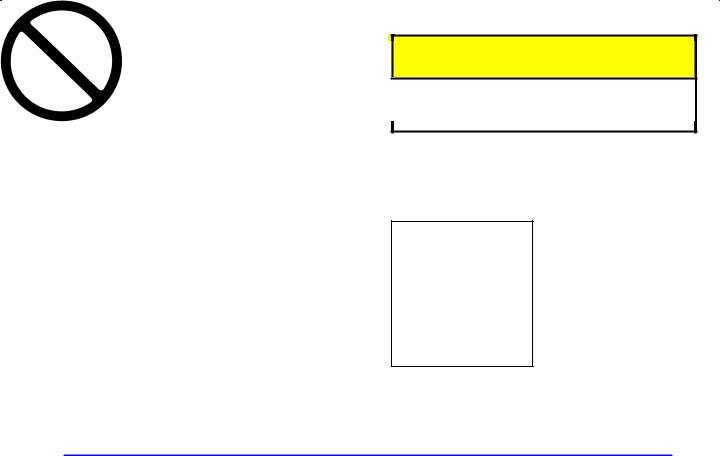
How to Use this Manual
Many people read their owner's manual from beginning to end when they first receive their new vehicle. If you do this, it will help you learn about the features and controls for your vehicle. In this manual, you'll find that pictures and words work together to explain
things quickly.
Safety Warnings and Symbols
You will find a number of safety cautions in this book. We use a box and the word CAUTION to tell you about things that could hurt you if you were to ignore the warning.
 CAUTION:
CAUTION:
These mean there is something that could hurt you or other people.
In the caution area, we tell you what the hazard is. Then we tell you what to do to help avoid or reduce the hazard. Please read these cautions. If you don't, you or others could be hurt.
You will also find a circle with a slash through it in this book. This safety symbol means ªDon't,º ªDon't do thisº or ªDon't let this happen.º
iii
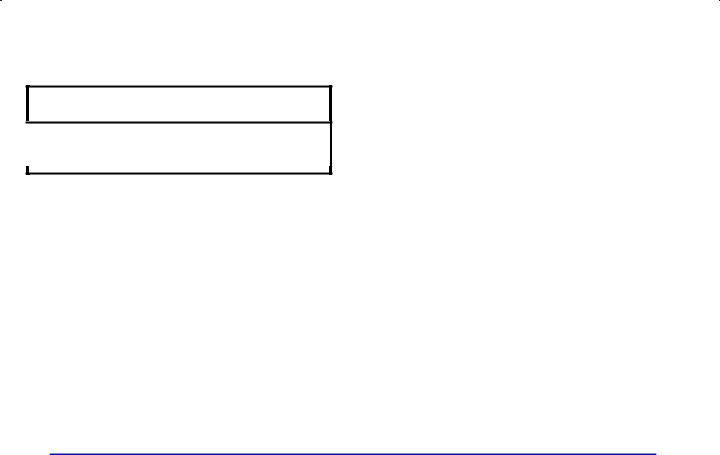
Vehicle Damage Warnings
Also, in this book you will find these notices:
NOTICE:
These mean there is something that could damage your vehicle.
In the notice area, we tell you about something that can damage your vehicle. Many times, this damage would not be covered by your warranty, and it could be costly. But the notice will tell you what to do to help avoid the damage.
When you read other manuals, you might see CAUTION and NOTICE warnings in different colors or in different words.
You'll also see warning labels on your vehicle. They use the same words, CAUTION or NOTICE.
Vehicle Symbols
Your vehicle may be equipped with components and labels that use symbols instead of text. Symbols, used on your vehicle, are shown along with the text describing the operation or information relating to a
specific component, control, message, gage or indicator.
If you need help figuring out a specific name of a component, gage or indicator reference the following topics in the Index:
DªEngine Compartment Overviewº
DªInstrument Panelº
DªComfort Controlsº
DªAudio Systemsº
Also see ªWarning Lights and Gagesº in the Index.
iv
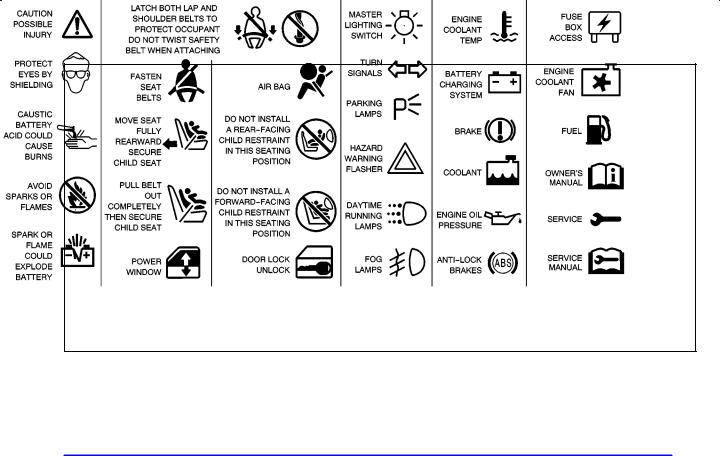
These are some examples of vehicle symbols you may find on your vehicle:
v
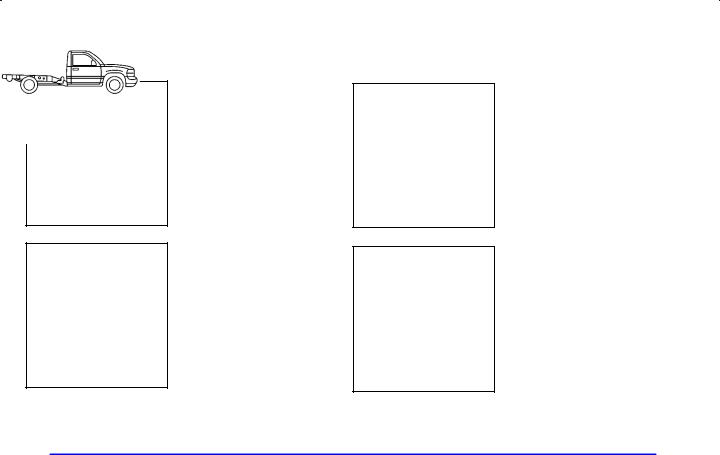
Model Reference
This manual covers these models:
Regular Cab Pickup
Extended Cab Pickup
Crew CabR
Chassis Cab
vi

Section 1 Seats and Restraint Systems
Here you'll find information about the seats in your vehicle and how to use your safety belts properly. You can also learn about some things you should not do with air bags and safety belts.
1-2 |
Seats and Seat Controls |
|
1-36 |
Rear Seat Passengers |
|
||||
1-10 |
Safety Belts: They're for Everyone |
|
1-40 |
Rear Safety Belt Comfort Guides for Children |
1-15 |
Here Are Questions Many People Ask About |
|
|
and Small Adults |
|
Safety Belts -- and the Answers |
|
1-42 |
Children |
1-16 |
How to Wear Safety Belts Properly |
|
1-46 |
Restraint Systems for Children |
1-16 |
Driver Position |
|
1-70 |
Older Children |
1-23 |
Safety Belt Use During Pregnancy |
|
1-73 |
Safety Belt Extender |
1-24 |
Right Front Passenger Position |
|
1-73 |
Checking Your Restraint Systems |
1-24 |
Air Bag System |
|
1-73 |
Replacing Restraint System Parts |
1-35 |
Center Passenger Position |
|
|
After a Crash |
|
|
|
|
|
1-1
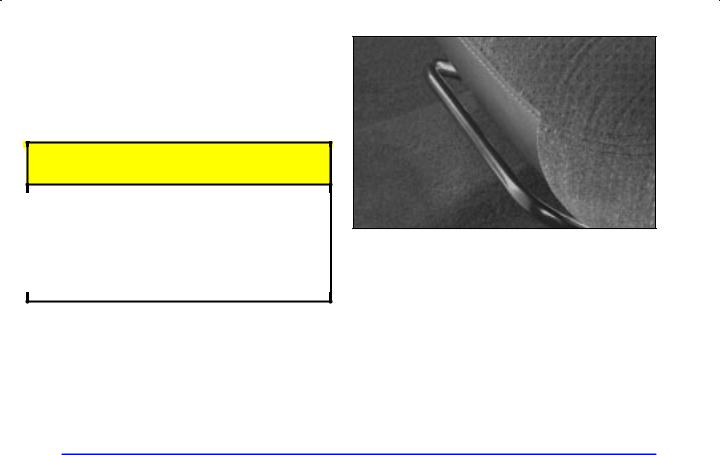
Seats and Seat Controls
This section tells you about the seats -- how to adjust them, and fold them up and down. It also tells you about reclining front seatbacks and head restraints.
Manual Front Seat
 CAUTION:
CAUTION:
You can lose control of the vehicle if you try to adjust a manual driver's seat while the vehicle is moving. The sudden movement could startle and confuse you, or make you push a pedal when you don't want to. Adjust the driver's seat only when the vehicle is not moving.
If your vehicle has a manual bucket or a split bench seat, you can adjust it with this lever located at the front of the seat.
Lift the lever to unlock the seat. Using your body, slide the seat to where you want it, and release the lever. Try to move the seat with your body to make sure the seat is locked into place.
1-2
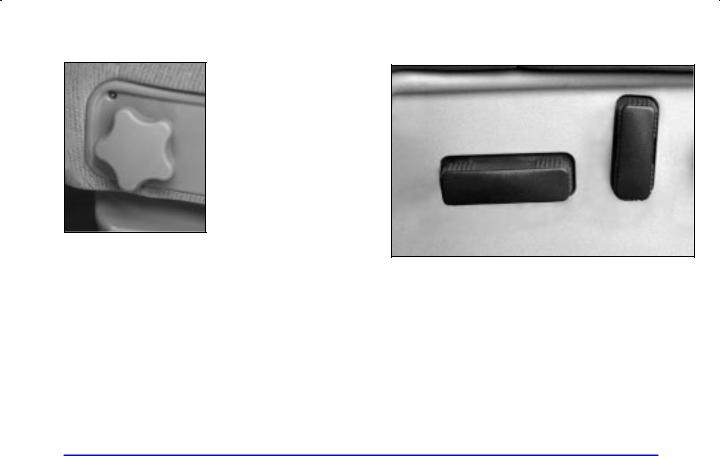
Manual Lumbar Control (If Equipped)
If your vehicle has a lumbar adjustment, the knob is located on the outboard side of the seat cushion.
To increase or decrease support, turn the knob toward the front or rear of the vehicle. Operating effort can be reduced if you lean forward slightly while turning the knob.
Power Seat(s) (If Equipped)
If your vehicle has a power seat, you can adjust it with these controls located on the outboard sides of the seats.
DRaise or lower the front of the seat cushion by raising or lowering the forward edge of the horizontal control.
1-3

DMove the seat forward or rearward by moving the whole horizontal control forward or rearward.
DRaise or lower the rear of the seat cushion by raising or lowering the rear edge of the horizontal control.
DMoving the whole horizontal control up or down raises or lowers the entire seat cushion.
If your vehicle has power reclining seats, you can use the vertical control to adjust the angle of the seatback. Move the reclining front seatback rearward or forward by moving the control toward the rear or the front of the vehicle. See ªReclining Seatbacksº in the Index for further information.
Power Lumbar Control (If Equipped)
If your vehicle has this feature, the four-way control is located on the outboard side of the seat.
To increase or decrease support, press and hold the front or rear of the control. Let go of the control when the lower seatback reaches the desired level of support.
You can also reshape the side wing area of the lower seatback for more lateral support. To increase or decrease support, press and hold the top or bottom of the control. Let go of the control when the lower seatback reaches the desired level of support.
1-4
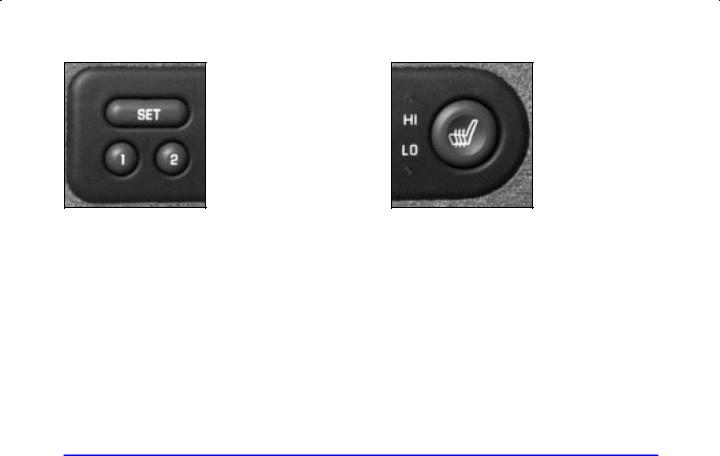
Memory Seat (If Equipped)
If your vehicle has this feature, the buttons used to program and recall the driver's seat and recliner position are located on the driver's door trim panel.
It does not store the lumbar or back support positions.
To program the memory seat, do the following:
1.Adjust the driver's seat to the desired position.
2.Then press the SET button and, within five seconds, press one of the two numbered buttons on the memory control.
To recall your setting, put the vehicle in PARK (P) and press the number you chose.
To program the seat position for a second driver, follow the preceding steps, but press the other number on the memory control.
Heated Front Seats (If Equipped)
If your vehicle has this feature, the button used to control the driver's heated seat is located on the driver's door panel. The button used to control the passenger's heated seat is located on the passenger's door panel.
To activate the heated seats, press the button once for the HI heat setting. Press the button again for the LO heat setting. To turn off the heated seats, press the button a third time. An indicator light will illuminate for each heat setting anytime the heated seats are operating.
The ignition must be in RUN for this feature to operate.
The heated front seats will be canceled after the ignition is turned to OFF. If you still want to use the heated front seat feature after you restart your vehicle, you will need to press the heated seat button again.
1-5
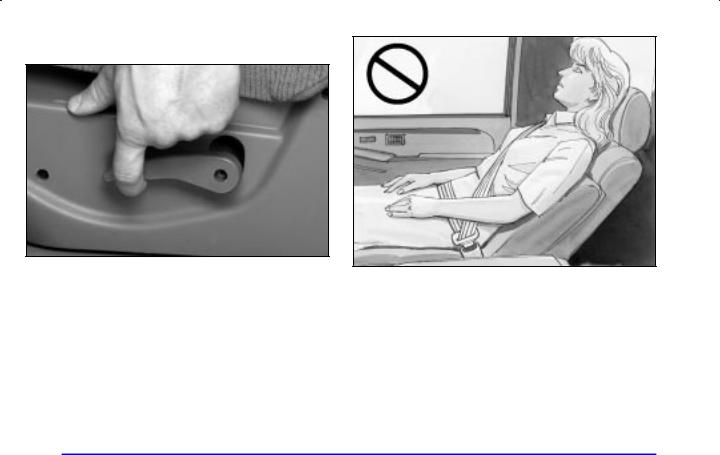
Reclining Seatbacks
To adjust the front seatback, lift the manual lever located on the outboard side of the seat. Release the lever to lock the seatback where you want it. Lift the lever again without pushing on the seatback and the seatback will go to an upright position.
If your vehicle has power seats with a power recliner, see ªPower Seatsº in the Index for further information on how to operate the reclining seatback feature.
But don't have a seatback reclined if your vehicle is moving.
1-6

 CAUTION:
CAUTION:
Sitting in a reclined position when your vehicle is in motion can be dangerous. Even if you buckle up, your safety belts can't do their job when you're reclined like this.
The shoulder belt can't do its job. In a crash, you could go into it, receiving neck or other injuries.
The lap belt can't do its job either. In a crash the belt could go up over your abdomen. The belt forces would be there, not at your pelvic bones. This could cause serious internal injuries.
For proper protection when the vehicle is in motion, have the seatback upright. Then sit well back in the seat and wear your safety belt properly.
Head Restraints
Slide the head restraint up or down so that the top of the restraint is closest to the top of your head. This position reduces the chance of a neck injury in a crash.
1-7
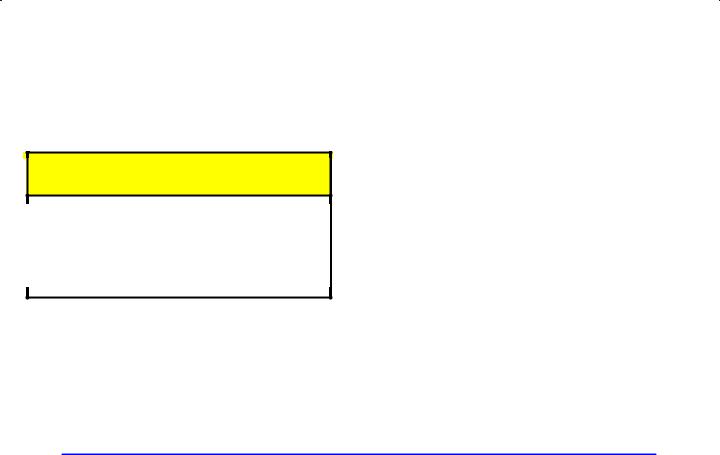
On some models, the head restraints tilt forward and rearward also.
The rear seat head restraints in your vehicle may be adjustable. They work the same as the front seat head restraints, except they do not tilt forward or rearward.
Seatback Latches
 CAUTION:
CAUTION:
If the seatback isn't locked, it could move forward in a sudden stop or crash. That could cause injury to the person sitting there. Always press rearward on the seatback to be sure it
is locked.
The seatbacks fold forward to let you access the rear of the cab.
To fold a front seatback forward, lift the lever at the base of the seat to release the seatback.
The lever is located on the outboard side of the seat cushion.
To return the seatback to the upright position, push the seatback rearward until it latches. After returning the seatback to its upright position, push and pull on the seatback to make sure it is locked.
1-8
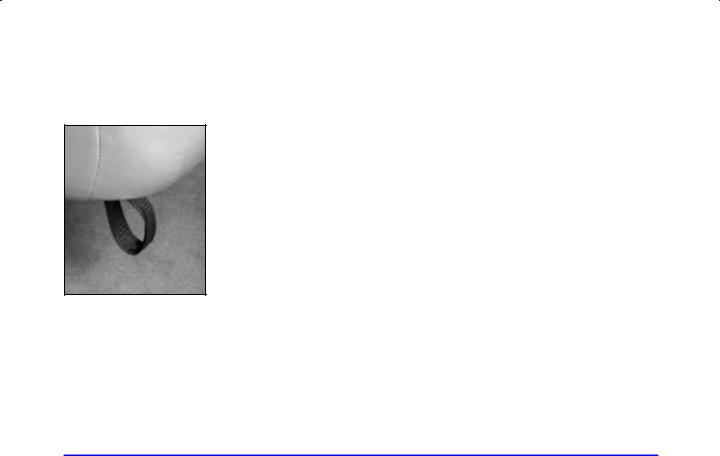
Rear Seat (Extended Cab)
Folding the Rear Seat
The extended cab's rear seat can be folded up to provide more cargo space. To fold the seat do the following:
1. Pull forward on the release strap located under the rear seat cushion.
2.Fold the seat cushion upward until it latches with the seatback.
3.Push and pull on the seat to make sure the seat is secure.
The extended cab's rear seat can also be folded open for more seating space. To use the seat do the following:
1.Push rearward on the seat cushion while pulling up on the release strap under the seat cushion. Pull the seat cushion downward until it latches.
2.After pulling the seat cushion down, pull up on it to make sure it is locked.
Rear Seat (Crew Cab)R
The second row rear seat has a 60/40 split seat. Either side of the rear seat may be folded down to give you more cargo space.
Before folding the rear seat on the driver's side, insert the two buckles into the retainer in the seatback. That way, the buckles will be out of the way when the seat is folded and will be available for passengers to use when the seat is returned to the passenger position. Also, make sure that nothing is under or in front of the seat and that the head restraints are completely lowered.
1-9
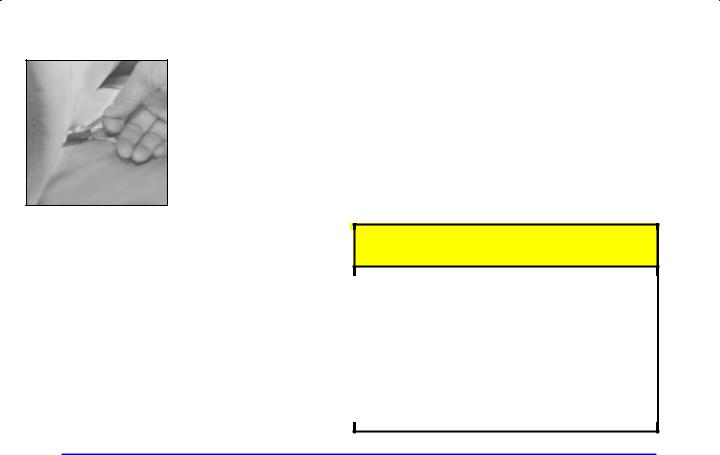
To fold the rear seat, do the following:
1. Pull up on the strap loop at the rear of the seat cushion. Then, pull the seat cushion up and fold it forward.
2.After folding the seat cushion fully forward, pull the seatback forward and fold the seatback down until it is flat. If the seatback cannot fold flat because it interferes with the cushion, try moving the front seat forward and/or bringing the front seat more upright. The lever at the base of the seat must be turned rearward to release the seatback.
To return the seat to the passenger position do the following:
1.Lift the seatback up and push it rearward all the way.
2.Lower the seat cushion until it latches into position.
3.Pull forward on the seatback and up on the seat cushion to make sure the seat is securely in place.
Check to see that the buckles on the driver's side seatback are accessible to the outboard and center occupant and are not under the seat cushions.
Safety Belts: They're for Everyone
This part of the manual tells you how to use safety belts properly. It also tells you some things you should not do with safety belts.
And it explains the air bag system.
 CAUTION:
CAUTION:
Don't let anyone ride where he or she can't wear a safety belt properly. If you are in a crash and you're not wearing a safety belt, your injuries can be much worse. You can hit things inside the vehicle or be ejected from it. You can be seriously injured or killed. In the same crash, you might not be if you are buckled up. Always fasten your safety belt, and check that your passengers' belts are fastened properly too.
1-10
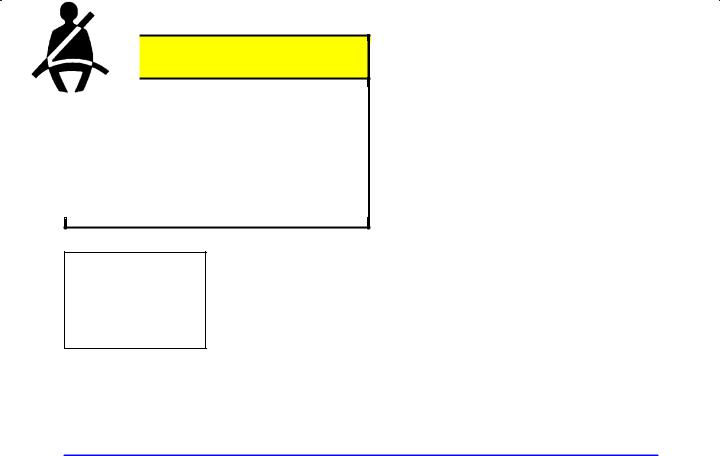
 CAUTION:
CAUTION:
It is extremely dangerous to ride in a cargo area, inside or outside of a vehicle. In a collision, people riding in these areas are more likely to be seriously injured or killed. Do not allow people to ride in any area of your vehicle that is not equipped with seats and safety belts. Be sure everyone in your vehicle is in a seat and using a safety belt properly.
Your vehicle has a light that comes on as a reminder to buckle up. See ªSafety Belt Reminder Lightº in the Index.
In most states and Canadian provinces, the law says to wear safety belts. Here's why: They work.
You never know if you'll be in a crash. If you do have a crash, you don't know if it will be a bad one.
A few crashes are mild, and some crashes can be so serious that even buckled up a person wouldn't survive. But most crashes are in between. In many of them, people who buckle up can survive and sometimes walk away. Without belts they could have been badly hurt
or killed.
After more than 30 years of safety belts in vehicles, the facts are clear. In most crashes buckling up does matter ... a lot!
Why Safety Belts Work
When you ride in or on anything, you go as fast as it goes.
1-11
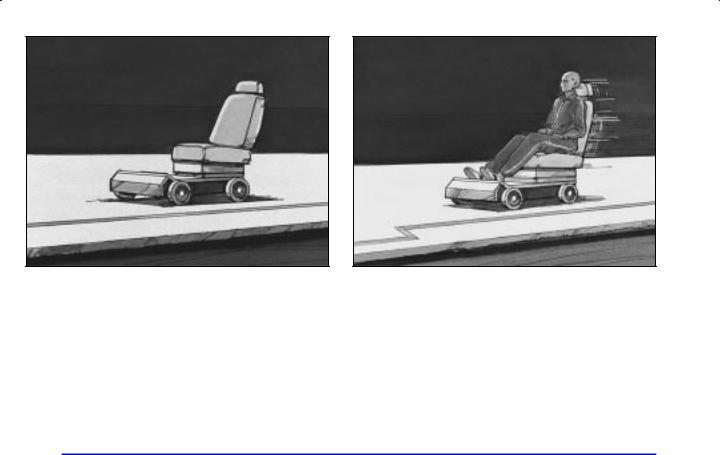
Take the simplest vehicle. Suppose it's just a seat |
Put someone on it. |
on wheels. |
|
1-12
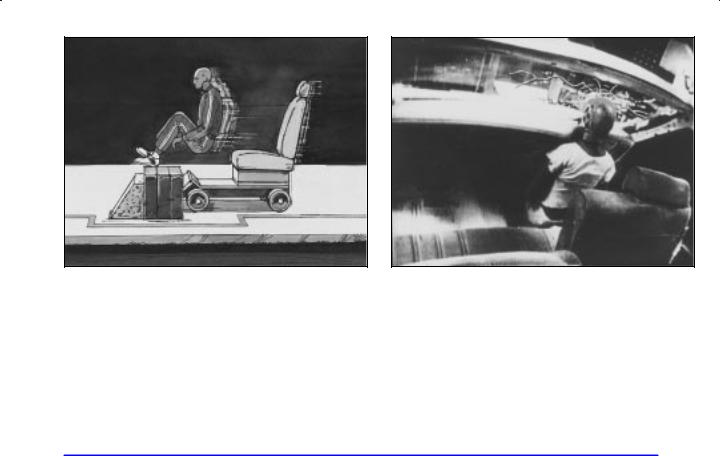
Get it up to speed. Then stop the vehicle. The rider doesn't stop.
The person keeps going until stopped by something.
In a real vehicle, it could be the windshield ...
1-13
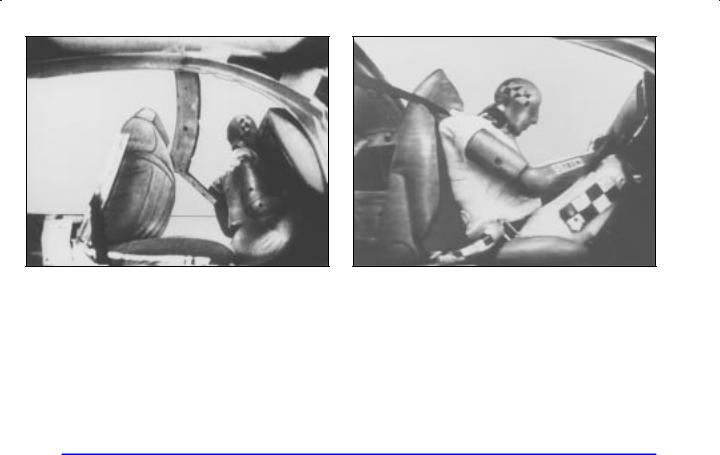
or the instrument panel ... |
or the safety belts! |
|
With safety belts, you slow down as the vehicle does. |
|
You get more time to stop. You stop over more distance, |
|
and your strongest bones take the forces. That's why |
|
safety belts make such good sense. |
1-14

Here Are Questions Many People Ask About Safety Belts -- and the Answers
Q: Won't I be trapped in the vehicle after an accident if I'm wearing a safety belt?
A: You could be -- whether you're wearing a safety belt or not. But you can unbuckle a safety belt, even if you're upside down. And your chance of being conscious during and after an accident, so you can unbuckle and get out, is much greater if you are belted.
Q: If my vehicle has air bags, why should I have to wear safety belts?
A: Air bags are in many vehicles today and will be in most of them in the future. But they are supplemental systems only; so they work with safety belts -- not instead of them. Every air bag system ever offered for sale has required the use of safety belts. Even if you're in a vehicle that has air bags, you still have to buckle up to get the most protection. That's true not only in frontal collisions, but especially in side and other collisions.
Q: If I'm a good driver, and I never drive far from home, why should I wear safety belts?
A: You may be an excellent driver, but if you're in an accident -- even one that isn't your fault -- you and your passengers can be hurt. Being a good driver doesn't protect you from things beyond your control, such as bad drivers.
Most accidents occur within 25 miles (40 km) of home. And the greatest number of serious injuries and deaths occur at speeds of less than 40 mph (65 km/h).
Safety belts are for everyone.
1-15
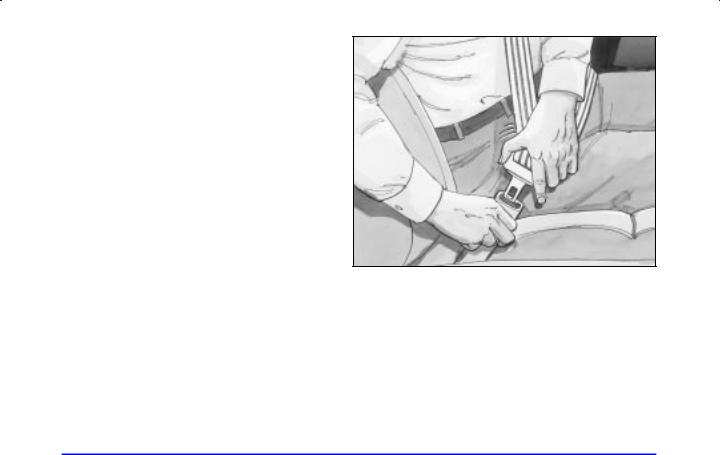
How to Wear Safety Belts Properly
Adults
This part is only for people of adult size.
Be aware that there are special things to know
about safety belts and children. And there are different rules for smaller children and babies. If a child will
be riding in your vehicle, see the part of this manual called ªChildren.º Follow those rules for everyone's protection.
First, you'll want to know which restraint systems your vehicle has.
We'll start with the driver position.
Driver Position
This part describes the driver's restraint system.
Lap-Shoulder Belt
The driver has a lap-shoulder belt. Here's how to wear it properly.
1.Close and lock the door.
2.Adjust the seat so you can sit up straight. To see how, see ªSeatsº in the Index.
3.Pick up the latch plate and pull the belt across you. Don't let it get twisted.
The shoulder belt may lock if you pull the belt across you very quickly. If this happens, let the belt go back slightly to unlock it. Then pull the belt across you more slowly.
1-16
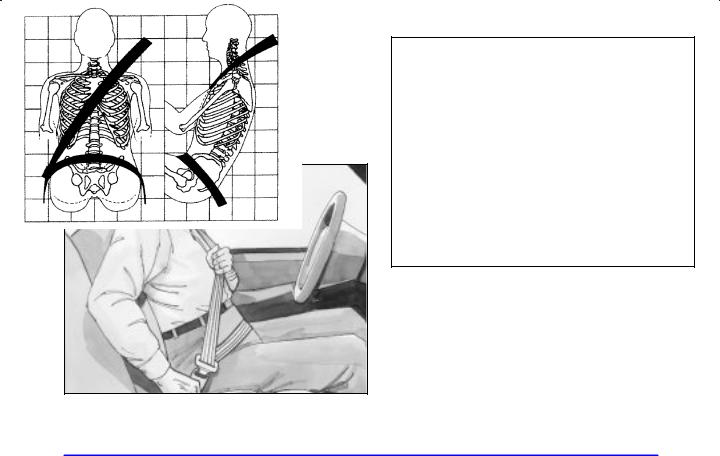
4.Push the latch plate into the buckle until it clicks.
Pull up on the latch plate to make sure it is secure. If the belt isn't long enough, see ªSafety Belt Extenderº at the end of this section.
Make sure the release button on the buckle is positioned so you would be able to unbuckle the safety belt quickly if you ever had to.
5.To make the lap part tight, pull down on the buckle end of the belt as you pull up on the shoulder belt.
The lap part of the belt should be worn low and snug on the hips, just touching the thighs. In a crash, this applies force to the strong pelvic bones. And you'd be less likely to slide under the lap belt. If you slid under it, the belt would apply force at your abdomen. This could cause serious or even fatal injuries. The shoulder belt should go over the shoulder and across the chest. These parts of the body are best able to take belt restraining forces.
The safety belt locks if there's a sudden stop or crash, or if you pull the belt very quickly out of the retractor.
1-17
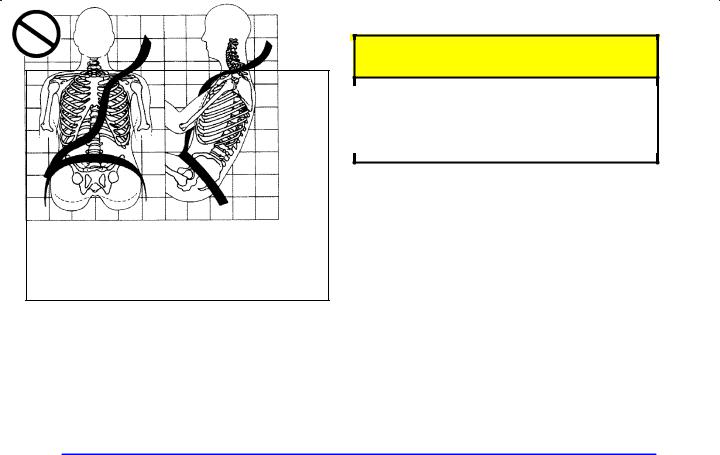
Q: What's wrong with this?
A: The shoulder belt is too loose. It won't give nearly as much protection this way.
 CAUTION:
CAUTION:
You can be seriously hurt if your shoulder belt is too loose. In a crash, you would move forward too much, which could increase injury. The shoulder belt should fit against your body.
1-18
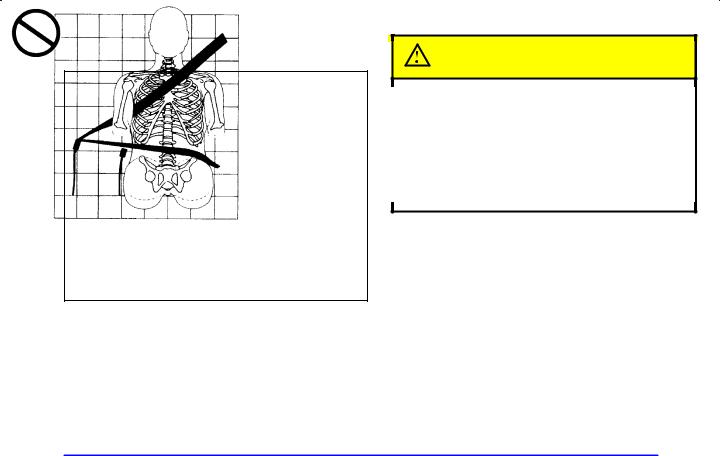
Q: What's wrong with this?
CAUTION:
You can be seriously injured if your belt is buckled in the wrong place like this. In a crash, the belt would go up over your abdomen. The belt forces would be there, not at the pelvic bones. This could cause serious internal injuries. Always buckle your belt into the buckle nearest you.
A: The belt is buckled in the wrong place.
1-19
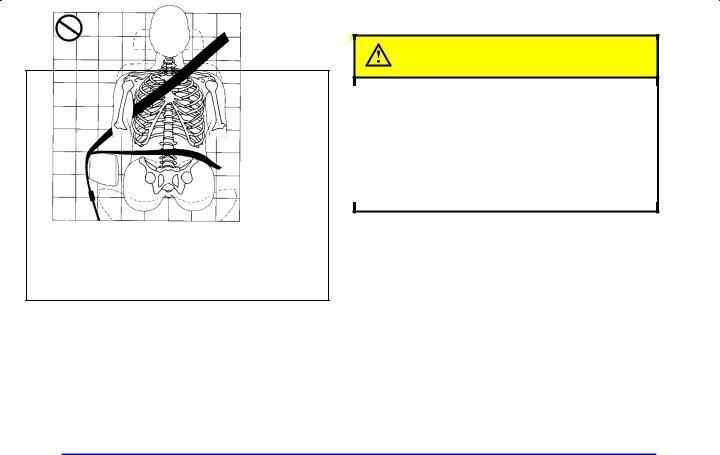
Q: What's wrong with this?
CAUTION:
You can be seriously injured if your belt goes over an armrest like this. The belt would be much too high. In a crash, you can slide under the belt. The belt force would then be applied at the abdomen, not at the pelvic bones, and that could cause serious or fatal injuries. Be sure the belt goes under the armrests.
A: The belt is over an armrest.
1-20
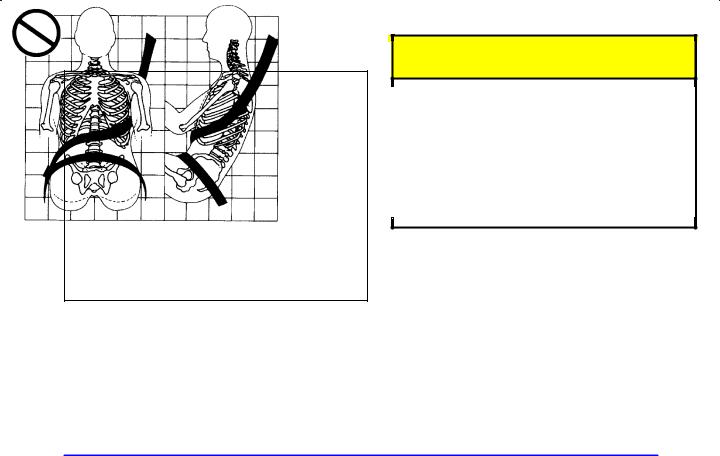
Q: What's wrong with this?
A: The shoulder belt is worn under the arm. It should be worn over the shoulder at all times.
 CAUTION:
CAUTION:
You can be seriously injured if you wear the shoulder belt under your arm. In a crash, your body would move too far forward, which would increase the chance of head and neck injury. Also, the belt would apply too much force to the ribs, which aren't as strong as shoulder bones. You could also severely injure internal organs like your liver or spleen.
1-21
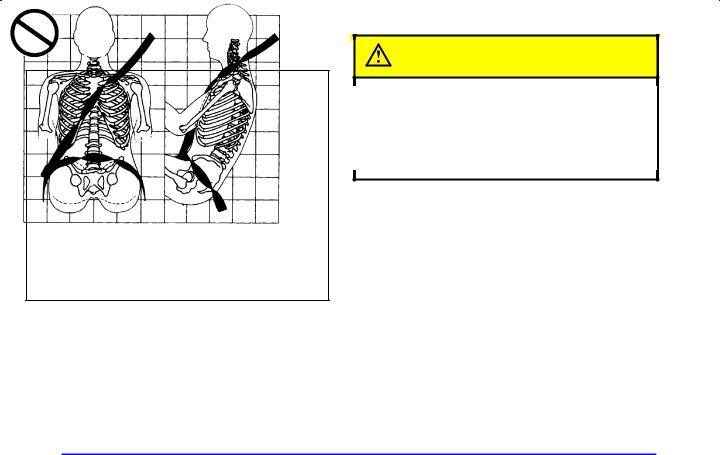
Q: What's wrong with this?
CAUTION:
You can be seriously injured by a twisted belt. In a crash, you wouldn't have the full width of the belt to spread impact forces. If a belt is twisted, make it straight so it can work properly, or ask your dealer to fix it.
A: The belt is twisted across the body.
1-22
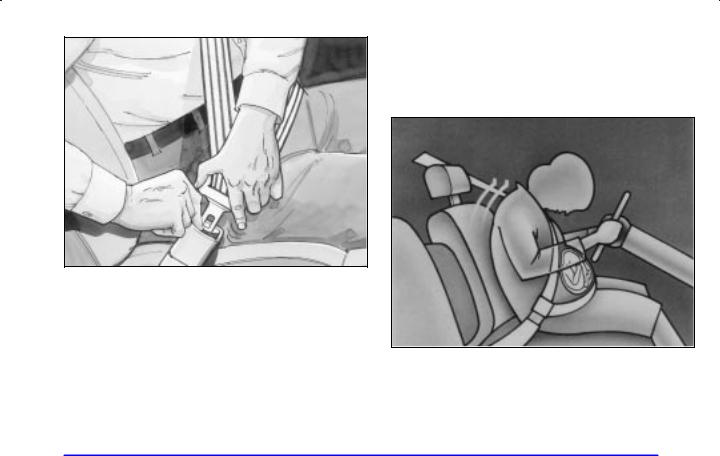
To unlatch the belt, just push the button on the buckle. The belt should go back out of the way.
Before you close the door, be sure the belt is out of the way. If you slam the door on it, you can damage both the belt and your vehicle.
Safety Belt Use During Pregnancy
Safety belts work for everyone, including pregnant women. Like all occupants, they are more likely to be seriously injured if they don't wear safety belts.
A pregnant woman should wear a lap-shoulder belt, and the lap portion should be worn as low as possible, below the rounding, throughout the pregnancy.
1-23
